Dario Spiller
Efficient FPGA-accelerated Convolutional Neural Networks for Cloud Detection on CubeSats
Apr 04, 2025Abstract:We present the implementation of four FPGA-accelerated convolutional neural network (CNN) models for onboard cloud detection in resource-constrained CubeSat missions, leveraging Xilinx's Vitis AI (VAI) framework and Deep Learning Processing Unit (DPU), a programmable engine with pre-implemented, parameterizable IP cores optimized for deep neural networks, on a Zynq UltraScale+ MPSoC. This study explores both pixel-wise (Pixel-Net and Patch-Net) and image-wise (U-Net and Scene-Net) models to benchmark trade-offs in accuracy, latency, and model complexity. Applying channel pruning, we achieved substantial reductions in model parameters (up to 98.6%) and floating-point operations (up to 90.7%) with minimal accuracy loss. Furthermore, the VAI tool was used to quantize the models to 8-bit precision, ensuring optimized hardware performance with negligible impact on accuracy. All models retained high accuracy post-FPGA integration, with a cumulative maximum accuracy drop of only 0.6% after quantization and pruning. The image-wise Scene-Net and U-Net models demonstrated strong real-time inference capabilities, achieving frame rates per second of 57.14 and 37.45, respectively, with power consumption of around 2.5 W, surpassing state-of-the-art onboard cloud detection solutions. Our approach underscores the potential of DPU-based hardware accelerators to expand the processing capabilities of small satellites, enabling efficient and flexible onboard CNN-based applications.
* 11 pages, Published in IEEE Journal on Miniaturization for Air and Space Systems
Quanv4EO: Empowering Earth Observation by means of Quanvolutional Neural Networks
Jul 24, 2024



Abstract:A significant amount of remotely sensed data is generated daily by many Earth observation (EO) spaceborne and airborne sensors over different countries of our planet. Different applications use those data, such as natural hazard monitoring, global climate change, urban planning, and more. Many challenges are brought by the use of these big data in the context of remote sensing applications. In recent years, employment of machine learning (ML) and deep learning (DL)-based algorithms have allowed a more efficient use of these data but the issues in managing, processing, and efficiently exploiting them have even increased since classical computers have reached their limits. This article highlights a significant shift towards leveraging quantum computing techniques in processing large volumes of remote sensing data. The proposed Quanv4EO model introduces a quanvolution method for preprocessing multi-dimensional EO data. First its effectiveness is demonstrated through image classification tasks on MNIST and Fashion MNIST datasets, and later on, its capabilities on remote sensing image classification and filtering are shown. Key findings suggest that the proposed model not only maintains high precision in image classification but also shows improvements of around 5\% in EO use cases compared to classical approaches. Moreover, the proposed framework stands out for its reduced parameter size and the absence of training quantum kernels, enabling better scalability for processing massive datasets. These advancements underscore the promising potential of quantum computing in addressing the limitations of classical algorithms in remote sensing applications, offering a more efficient and effective alternative for image data classification and analysis.
Autonomous crater detection on asteroids using a fully-convolutional neural network
Apr 01, 2022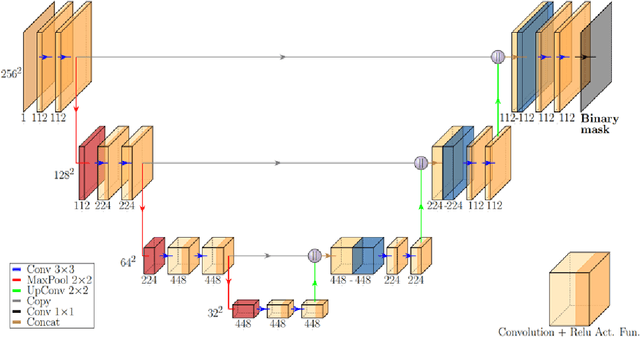

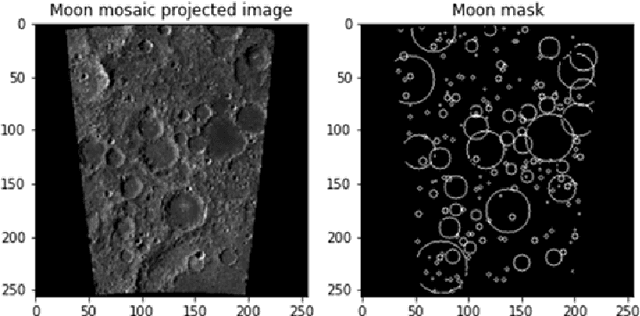

Abstract:This paper shows the application of autonomous Crater Detection using the U-Net, a Fully-Convolutional Neural Network, on Ceres. The U-Net is trained on optical images of the Moon Global Morphology Mosaic based on data collected by the LRO and manual crater catalogues. The Moon-trained network will be tested on Dawn optical images of Ceres: this task is accomplished by means of a Transfer Learning (TL) approach. The trained model has been fine-tuned using 100, 500 and 1000 additional images of Ceres. The test performance was measured on 350 never before seen images, reaching a testing accuracy of 96.24%, 96.95% and 97.19%, respectively. This means that despite the intrinsic differences between the Moon and Ceres, TL works with encouraging results. The output of the U-Net contains predicted craters: it will be post-processed applying global thresholding for image binarization and a template matching algorithm to extract craters positions and radii in the pixel space. Post-processed craters will be counted and compared to the ground truth data in order to compute image segmentation metrics: precision, recall and F1 score. These indices will be computed, and their effect will be discussed for tasks such as automated crater cataloguing and optical navigation.
On Circuit-based Hybrid Quantum Neural Networks for Remote Sensing Imagery Classification
Sep 20, 2021



Abstract:This article aims to investigate how circuit-based hybrid Quantum Convolutional Neural Networks (QCNNs) can be successfully employed as image classifiers in the context of remote sensing. The hybrid QCNNs enrich the classical architecture of CNNs by introducing a quantum layer within a standard neural network. The novel QCNN proposed in this work is applied to the Land Use and Land Cover (LULC) classification, chosen as an Earth Observation (EO) use case, and tested on the EuroSAT dataset used as reference benchmark. The results of the multiclass classification prove the effectiveness of the presented approach, by demonstrating that the QCNN performances are higher than the classical counterparts. Moreover, investigation of various quantum circuits shows that the ones exploiting quantum entanglement achieve the best classification scores. This study underlines the potentialities of applying quantum computing to an EO case study and provides the theoretical and experimental background for futures investigations.
On Board Volcanic Eruption Detection through CNNs and Satellite Multispectral Imagery
Jul 28, 2021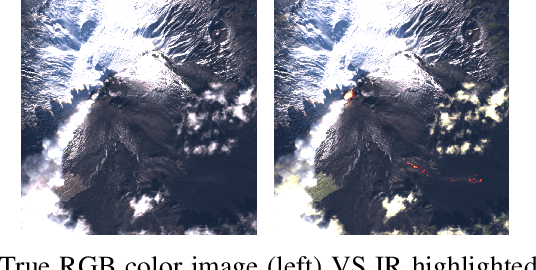
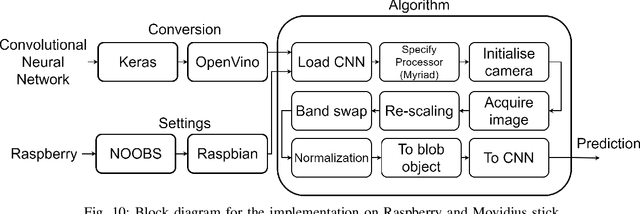

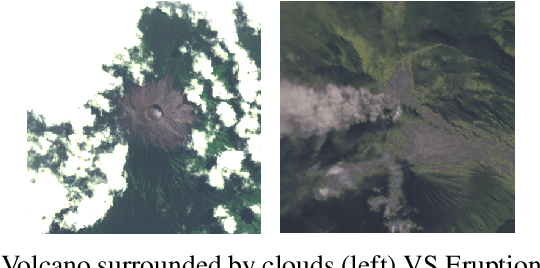
Abstract:In recent years, the growth of Machine Learning (ML) algorithms has raised the number of studies including their applicability in a variety of different scenarios. Among all, one of the hardest ones is the aerospace, due to its peculiar physical requirements. In this context, a feasibility study and a first prototype for an Artificial Intelligence (AI) model to be deployed on board satellites are presented in this work. As a case study, the detection of volcanic eruptions has been investigated as a method to swiftly produce alerts and allow immediate interventions. Two Convolutional Neural Networks (CNNs) have been proposed and designed, showing how to efficiently implement them for identifying the eruptions and at the same time adapting their complexity in order to fit on board requirements.
Advantages and Bottlenecks of Quantum Machine Learning for Remote Sensing
Jan 28, 2021



Abstract:This concept paper aims to provide a brief outline of quantum computers, explore existing methods of quantum image classification techniques, so focusing on remote sensing applications, and discuss the bottlenecks of performing these algorithms on currently available open source platforms. Initial results demonstrate feasibility. Next steps include expanding the size of the quantum hidden layer and increasing the variety of output image options.
 Add to Chrome
Add to Chrome Add to Firefox
Add to Firefox Add to Edge
Add to Edge